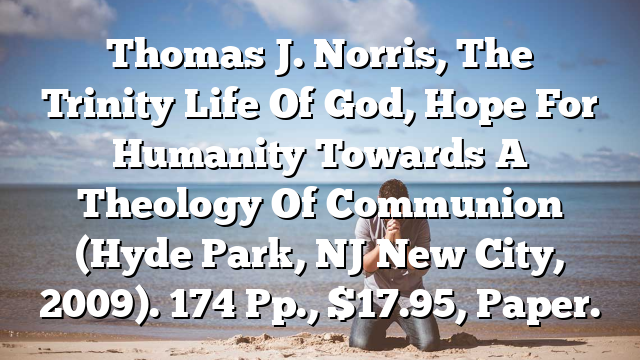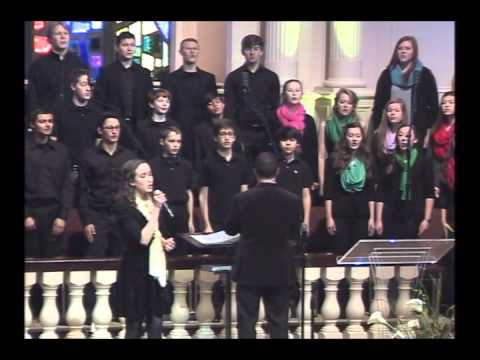Click to join the conversation with over 500,000 Pentecostal believers and scholars
Click to get our FREE MOBILE APP and stay connected
| PentecostalTheology.com



162
Book Reviews / Pneuma 32 (2010) 123-175
Thomas J. Norris, The Trinity–Life of God, Hope for Humanity: Towards a Theology of Com- munion (Hyde Park, NJ: New City, 2009). 174 pp., $17.95, paper.
Thomas J. Norris presents a spirituality of communion based on a trinitarian ontology. Beginning in chapter one with an examination of Dei Verbum, he situates his call for a spirituality of communion in light of recent Catholic conciliar teaching. Chapter two details the “Law of the Trinity,” which is Jesus’ “new commandment,” the commandment to love. The mutual love between the Father and the Son illuminates the commandment to love. In John 17:21-24, Jesus prays that his followers will participate in the love he enjoys with the Father and that they will extend that love to others. Chapter three presents Jesus’ God-forsakenness on the cross as the paradigm of love. Jesus encourages his disciples, “as the Father has loved me, so have I loved you,” and then exhorts them to “love one another as I have loved you” (John 15:9 and 12). For Norris, the “as” is the hermeneutical key to understanding the nature of Christian love. As the recipient of the Father’s love in the Incarnation, Jesus pours out the same love on humanity. His love reaches its zenith on the cross, where he utterly and radically expresses his devotion both to the Father and to all human beings. Norris calls Christ’s radical expression of love on the cross the measure and method of love. It is the measure because love gives to the utmost and the method because love entails utter identifi cation with those loved. In respect to Christian discipleship, Christ calls his followers to embody love to others in the same radical way that he did; thus, as we are loved by the Son, so we are to love as the Son. Chapter four, refreshing for the way it connects theology and the Christian life, illustrates the way a spirituality of communion relates to the concrete world of economics. Norris showcases the Focolare Movement, initi- ated by the self-sacrifi cing service of Chiara Lubich and her friends during the closing days of the Second World War in and around the city of Trent. Inspired by the conviction that God is love and God calls his followers to embody love to others in tangible ways, Lubich and her friends began serving the people dispossessed and injured from allied bombing raids through a “communion of goods.” As the result of becoming an international move- ment, in the 1990s Focolare members initiated an “Economy of Communion,” which founds and operates businesses according to a logic of solidarity: profi ts are reinvested in the business, distributed to people in need, and invested in educational institutions that promote a “culture of giving.” It is an economic practice that organizes economic activity around the needs of a community of people rather than individuals’ consumption and accumulation of possessions. Recognizing the downfall of ontology in modern philosophy, chapter fi ve sets forth a trinitarian ontology that promises to overcome the individualism and atomization of contemporary life. Norris summarizes his ontology as “to be is to love, and to love is to give, to give truly is to give oneself completely” (145). The process of loving and giving derives from the relations that characterize the divine persons. The Father from eternity gives himself utterly in the generation of the Son, who in turn abandons himself in love to the Father. The Holy Spirit loses himself in uniting the Father and the Son in loving communion.
Although recognizing a tendency to neglect pneumatology, Norris’s trinitarian ontology and the spirituality of communion depend largely on the loving relations between the Father and the Son. The Father-Son focus of the text derives in part from Norris’ reliance
© Koninklijke Brill NV, Leiden, 2010 DOI: 10.1163/027209610X12628362888513
1
Book Reviews / Pneuma 32 (2010) 123-175
163
on certain passages in the Gospel of John. John undoubtedly emphasizes the loving devo- tion that characterizes the relationship of the Father and the Son, but John also presents the Spirit as a central player in the constitution of the unity and fellowship Christ’s followers are to have with him, the Father, and one another (e.g., John 14:15, 25-26; 15:26; and 16:12-15). Norris also assumes the mutual love model of the Trinity, but his spirituality of communion trades on Christ’s love for the Father and all human beings to such an extent that the Holy Spirit as the divine person who constitutes the communion of love between the Father and the Son plays no central role in articulating the spirituality of communion. I would like to have seen some more pneumatological development for the obvious trinitar- ian reason and for the author’s recognition that the theological tradition exhibits a pneuma- tological defi cit. Norris’ proposal is also crucicentric. He sees the Trinity and the cross as the “core mysteries of the Christian faith” (152); but what about the resurrection and the out- pouring of the Spirit by the risen Christ? Yes, the cross reveals that Christ’s love for the Father and human beings knows no bounds, but his loving presence with humanity in the historical particularity of the cross attains universal scope in the resurrection and especially Pentecost.
One fi nal point is Norris’s suggestion that a communitarian vision can serve as the basis for refashioning society and particularly economic life according to a “we-rationality,” which gives precedence to people and the common welfare rather than to the individualism and greed that fuels modern capitalist economies. T ough the call for Christians to embody an other-oriented love in terms of their concrete business practices (for example, equitable distribution of the fruit of economic production) and other dimensions of their lives is certainly correct, the desire to restructure broader social institutions and practices is prob- lematic. If a “we-rationality” becomes institutionalized and bureaucratized in societal struc- tures, it ceases being a community of freely assenting Christians and thus also an act of self-giving on the behalf of others.
Overall, the book is readable and related to concrete issues of Christian discipleship, such as economics. T eologians often claim that the Trinity can inform the Christian life, but the ramifi cations just as often remain opaque. Norris eff ectively discusses the Trinity in a way that is both intelligible to the non-specialist and related directly to issues of Christian formation.
Reviewed by Steven M. Studebaker
Assistant Professor of Systematic and Historical Theology, and Howard and Shirley Bentall Chair in Evangelical Thought McMaster Divinity College, McMaster University, ON, Canada
2




Most Talked About Today